

Problem Solving Wheel: Help Kids Solve Their Own Problems
Students who act out in aggressive behaviors often do so because they struggle with identifying solutions to their problems. A Problem-Solving Wheel can help teach your students to learn how to independently solve a problem.
A problem-solving wheel also known as the wheel of choice or solution wheel is a great way to give students a visual of choices to help them either calm down when they are upset or to help them solve a problem with a classmate.
It is best to use the problem-solving wheel when students are dealing with a “small” problem. “Small” problems include conflicts that cause “small” feelings of annoyance, embarrassment, boredom, etc. If the student has a BIG problem they should practice telling an adult. “BIG problems” are situations that are scary, dangerous, illegal, etc.
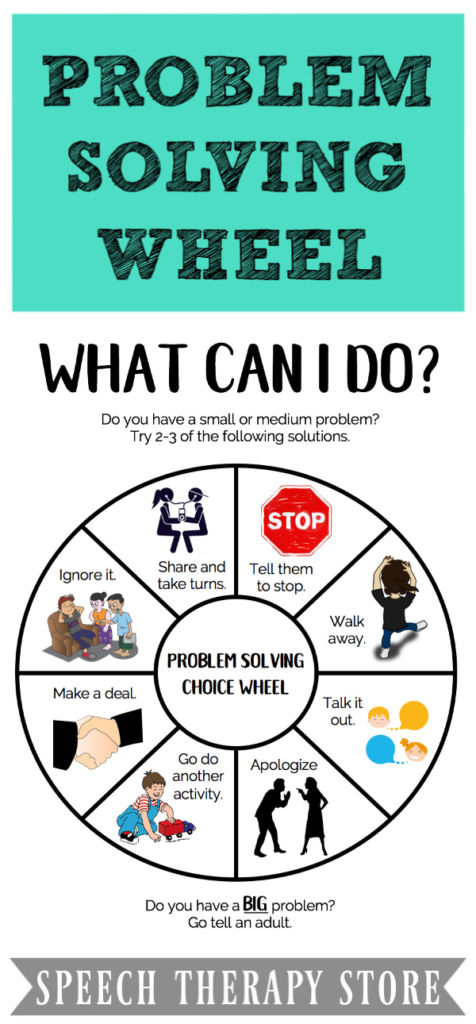
Examples of Small Problems
- A classmate broke your pencil
- Someone cut in front of them in line
- A classmate is using the color crayon they want to use
- A friend keeps kicking their chair
Conflict Resolution
Children don’t always know what to do when they are experiencing conflicts with others. When students are stressed and in the moment of a conflict they can often forget how to solve the problem A problem-solving choice wheel can help them learn different ways to solve their problems. I’ve created a few free printable problem-solving choice wheels for you to choose from. Simply download and start using in your classroom today!
Problem Solving Wheel Freebie
Comes in 4 different versions:
- Ready-Made: “What can I do?” choice wheel is ready to use right away. Simply download, print and start using this freebie!
- Blank with Pictures: Have your students add their own words to the pictures.
- Blank: Have your students draw their own pictures and write a short description.
- Editable Version: Using the free version of Adobe Acrobat Reader edit all the blue boxes with your own words.
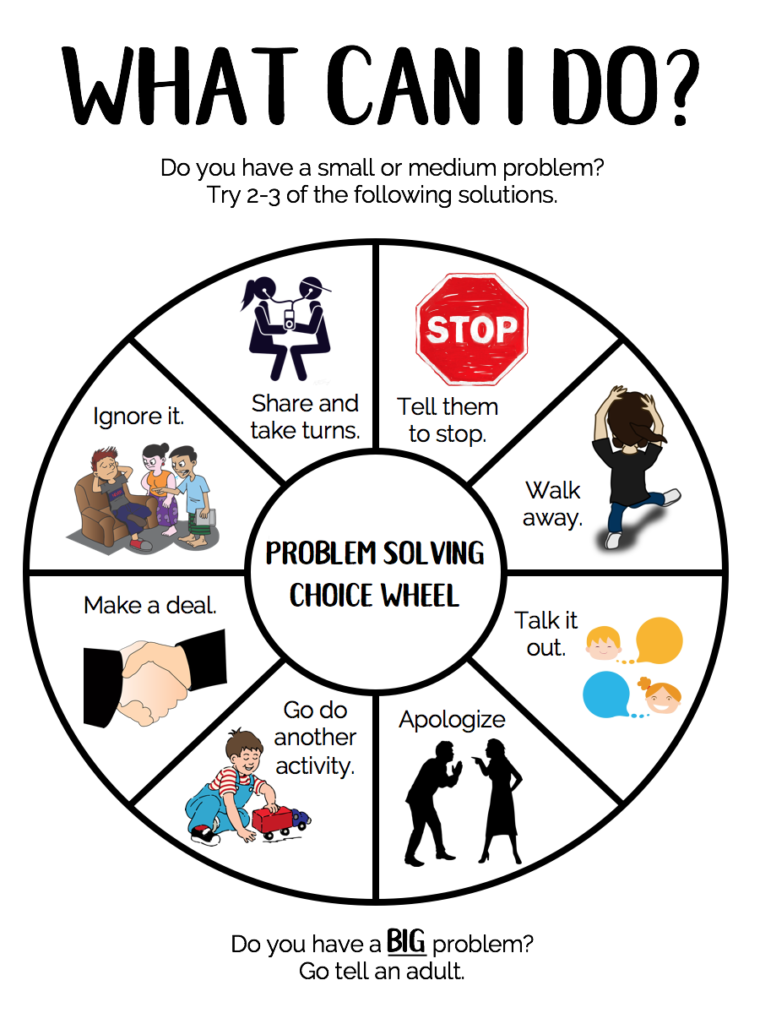
When you create a consistent pattern of how to solve problems students will eventually pick up on that pattern and begin to implement the pattern independently.
Send me the Problem Solving Choice Wheel!
Involve children in finding the solution..
Involving children in the problem-solving process can help give them buy-in into using the system that they take part in creating. Use the blank version or the editable version and have your students create their own ideas for how to solve “small” problems on their own. Your students might even surprise you and come up with some creative solutions.
Teach Feeling Words
In addition, for some of our students teaching feeling words can help them have the vocabulary necessary to express how they are feeling during a problem. We can start by naming students’ feelings for them and after some practice hopefully, the students will begin to use feeling words to describe how they are feeling during a conflict. For example, “Sam the way you yelled, “no” and stomped your feet tell me that you are angry.” Talking to our students this way can help bring their attention to their feelings so they can eventually identify their own feelings.
Help your students resolve a social conflict on their own with this – PROBLEM-SOLVING WHEEL .
Where to Begin
- Start by posting the PROBLEM-SOLVING WHEEL in a good spot in your classroom or office.
- Start slowly and use 1-2 solutions and build up to using all 6 solutions.
- Practice, practice, practice!
Helpful Tips
- Start slowly: practice using 1-2 choices at a time and slowly build up to using all six. Be clear about what each choice looks like in practice.
- Practice is critical: Even after introducing the Problem-Solving Wheel students will still depend on you to help them resolve their conflicts. Continue to modal and have your students practice.
Books on Problem Solving
For Younger Children: Recommended Ages 2-6
- The Little Mouse, The Red Ripe Strawberry, and the Big Hungry Bear
- Duncan the Story Dragon
- The Whale in my Swimming Pool
For Older Children: Recommended Ages 8-12
- Appleblossom the Possum
- Dough Knights and Dragons
- Rosie Revere, Engineer
Aggressive behaviors are often exhibited when a student struggles with identifying solutions to their problems. A problem-solving wheel can be a great way to give students a visual of choices to help them calm down and to solve a problem with a classmate or friend.
Grab your freebie printable today and get started helping your students independently solving their own problems!
Want More Problem Solving?
Be sure to check out my other problem-solving freebies:
- 31 Wordless Videos to Teach Problem-Solving
- 71+ Free Social Problem Solving Task Cards Scenarios
Get More Problem Solving Time Saving Materials
Next, be sure to check out the following time-saving materials to continue to teach your students how to solve their social problems in addition to this freebie.
Problem Size & Reaction Size
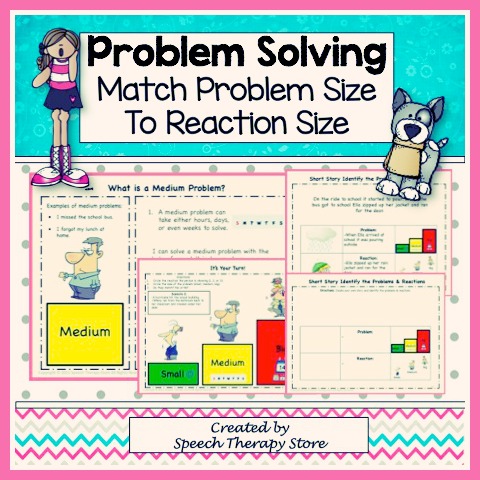
- Problem size and reaction size. Teach your students to identify the size of a problem and to match the size of the problem with their reaction size.
Weekly Social Pragmatics Homework

- Weekly problem-solving. Send home a weekly homework page that includes a problem-solving scenario plus an idiom and a conversational practice scenario.

Restorative Justice Problem Solving Flip Book

- Restorative justice graphic visual. Use this graphic visual to help your student restore a social relationship after a social problem.

Thursday 2nd of February 2023
Great idea!
71+ Free Social Problem-Solving Scenarios - Speech Therapy Store
Wednesday 23rd of October 2019
[…] with these small problems can be a great learning opportunity. Children can practice problem-solving with a small problem which can help them learn how to handle bigger problems in the […]
10 Best Problem-Solving Therapy Worksheets & Activities

Cognitive science tells us that we regularly face not only well-defined problems but, importantly, many that are ill defined (Eysenck & Keane, 2015).
Sometimes, we find ourselves unable to overcome our daily problems or the inevitable (though hopefully infrequent) life traumas we face.
Problem-Solving Therapy aims to reduce the incidence and impact of mental health disorders and improve wellbeing by helping clients face life’s difficulties (Dobson, 2011).
This article introduces Problem-Solving Therapy and offers techniques, activities, and worksheets that mental health professionals can use with clients.
Before you continue, we thought you might like to download our three Positive Psychology Exercises for free . These science-based exercises explore fundamental aspects of positive psychology, including strengths, values, and self-compassion, and will give you the tools to enhance the wellbeing of your clients, students, or employees.
This Article Contains:
What is problem-solving therapy, 14 steps for problem-solving therapy, 3 best interventions and techniques, 7 activities and worksheets for your session, fascinating books on the topic, resources from positivepsychology.com, a take-home message.
Problem-Solving Therapy assumes that mental disorders arise in response to ineffective or maladaptive coping. By adopting a more realistic and optimistic view of coping, individuals can understand the role of emotions and develop actions to reduce distress and maintain mental wellbeing (Nezu & Nezu, 2009).
“Problem-solving therapy (PST) is a psychosocial intervention, generally considered to be under a cognitive-behavioral umbrella” (Nezu, Nezu, & D’Zurilla, 2013, p. ix). It aims to encourage the client to cope better with day-to-day problems and traumatic events and reduce their impact on mental and physical wellbeing.
Clinical research, counseling, and health psychology have shown PST to be highly effective in clients of all ages, ranging from children to the elderly, across multiple clinical settings, including schizophrenia, stress, and anxiety disorders (Dobson, 2011).
Can it help with depression?
PST appears particularly helpful in treating clients with depression. A recent analysis of 30 studies found that PST was an effective treatment with a similar degree of success as other successful therapies targeting depression (Cuijpers, Wit, Kleiboer, Karyotaki, & Ebert, 2020).
Other studies confirm the value of PST and its effectiveness at treating depression in multiple age groups and its capacity to combine with other therapies, including drug treatments (Dobson, 2011).
The major concepts
Effective coping varies depending on the situation, and treatment typically focuses on improving the environment and reducing emotional distress (Dobson, 2011).
PST is based on two overlapping models:
Social problem-solving model
This model focuses on solving the problem “as it occurs in the natural social environment,” combined with a general coping strategy and a method of self-control (Dobson, 2011, p. 198).
The model includes three central concepts:
- Social problem-solving
- The problem
- The solution
The model is a “self-directed cognitive-behavioral process by which an individual, couple, or group attempts to identify or discover effective solutions for specific problems encountered in everyday living” (Dobson, 2011, p. 199).
Relational problem-solving model
The theory of PST is underpinned by a relational problem-solving model, whereby stress is viewed in terms of the relationships between three factors:
- Stressful life events
- Emotional distress and wellbeing
- Problem-solving coping
Therefore, when a significant adverse life event occurs, it may require “sweeping readjustments in a person’s life” (Dobson, 2011, p. 202).

- Enhance positive problem orientation
- Decrease negative orientation
- Foster ability to apply rational problem-solving skills
- Reduce the tendency to avoid problem-solving
- Minimize the tendency to be careless and impulsive
D’Zurilla’s and Nezu’s model includes (modified from Dobson, 2011):
- Initial structuring Establish a positive therapeutic relationship that encourages optimism and explains the PST approach.
- Assessment Formally and informally assess areas of stress in the client’s life and their problem-solving strengths and weaknesses.
- Obstacles to effective problem-solving Explore typically human challenges to problem-solving, such as multitasking and the negative impact of stress. Introduce tools that can help, such as making lists, visualization, and breaking complex problems down.
- Problem orientation – fostering self-efficacy Introduce the importance of a positive problem orientation, adopting tools, such as visualization, to promote self-efficacy.
- Problem orientation – recognizing problems Help clients recognize issues as they occur and use problem checklists to ‘normalize’ the experience.
- Problem orientation – seeing problems as challenges Encourage clients to break free of harmful and restricted ways of thinking while learning how to argue from another point of view.
- Problem orientation – use and control emotions Help clients understand the role of emotions in problem-solving, including using feelings to inform the process and managing disruptive emotions (such as cognitive reframing and relaxation exercises).
- Problem orientation – stop and think Teach clients how to reduce impulsive and avoidance tendencies (visualizing a stop sign or traffic light).
- Problem definition and formulation Encourage an understanding of the nature of problems and set realistic goals and objectives.
- Generation of alternatives Work with clients to help them recognize the wide range of potential solutions to each problem (for example, brainstorming).
- Decision-making Encourage better decision-making through an improved understanding of the consequences of decisions and the value and likelihood of different outcomes.
- Solution implementation and verification Foster the client’s ability to carry out a solution plan, monitor its outcome, evaluate its effectiveness, and use self-reinforcement to increase the chance of success.
- Guided practice Encourage the application of problem-solving skills across multiple domains and future stressful problems.
- Rapid problem-solving Teach clients how to apply problem-solving questions and guidelines quickly in any given situation.
Success in PST depends on the effectiveness of its implementation; using the right approach is crucial (Dobson, 2011).
Problem-solving therapy – Baycrest
The following interventions and techniques are helpful when implementing more effective problem-solving approaches in client’s lives.
First, it is essential to consider if PST is the best approach for the client, based on the problems they present.
Is PPT appropriate?
It is vital to consider whether PST is appropriate for the client’s situation. Therapists new to the approach may require additional guidance (Nezu et al., 2013).
Therapists should consider the following questions before beginning PST with a client (modified from Nezu et al., 2013):
- Has PST proven effective in the past for the problem? For example, research has shown success with depression, generalized anxiety, back pain, Alzheimer’s disease, cancer, and supporting caregivers (Nezu et al., 2013).
- Is PST acceptable to the client?
- Is the individual experiencing a significant mental or physical health problem?
All affirmative answers suggest that PST would be a helpful technique to apply in this instance.
Five problem-solving steps
The following five steps are valuable when working with clients to help them cope with and manage their environment (modified from Dobson, 2011).
Ask the client to consider the following points (forming the acronym ADAPT) when confronted by a problem:
- Attitude Aim to adopt a positive, optimistic attitude to the problem and problem-solving process.
- Define Obtain all required facts and details of potential obstacles to define the problem.
- Alternatives Identify various alternative solutions and actions to overcome the obstacle and achieve the problem-solving goal.
- Predict Predict each alternative’s positive and negative outcomes and choose the one most likely to achieve the goal and maximize the benefits.
- Try out Once selected, try out the solution and monitor its effectiveness while engaging in self-reinforcement.
If the client is not satisfied with their solution, they can return to step ‘A’ and find a more appropriate solution.

Download 3 Free Positive Psychology Exercises (PDF)
Enhance wellbeing with these free, science-based exercises that draw on the latest insights from positive psychology.
Download 3 Free Positive Psychology Tools Pack (PDF)
By filling out your name and email address below.
Positive self-statements
When dealing with clients facing negative self-beliefs, it can be helpful for them to use positive self-statements.
Use the following (or add new) self-statements to replace harmful, negative thinking (modified from Dobson, 2011):
- I can solve this problem; I’ve tackled similar ones before.
- I can cope with this.
- I just need to take a breath and relax.
- Once I start, it will be easier.
- It’s okay to look out for myself.
- I can get help if needed.
- Other people feel the same way I do.
- I’ll take one piece of the problem at a time.
- I can keep my fears in check.
- I don’t need to please everyone.

World’s Largest Positive Psychology Resource
The Positive Psychology Toolkit© is a groundbreaking practitioner resource containing over 500 science-based exercises , activities, interventions, questionnaires, and assessments created by experts using the latest positive psychology research.
Updated monthly. 100% Science-based.
“The best positive psychology resource out there!” — Emiliya Zhivotovskaya , Flourishing Center CEO
PST practitioners have many different techniques available to support clients as they learn to tackle day-to-day or one-off trauma.
5 Worksheets and workbooks
Problem-solving self-monitoring form.

Ask the client to complete the following:
- Describe the problem you are facing.
- What is your goal?
- What have you tried so far to solve the problem?
- What was the outcome?
Reactions to Stress
It can be helpful for the client to recognize their own experiences of stress. Do they react angrily, withdraw, or give up (Dobson, 2011)?
The Reactions to Stress worksheet can be given to the client as homework to capture stressful events and their reactions. By recording how they felt, behaved, and thought, they can recognize repeating patterns.
What Are Your Unique Triggers?
Helping clients capture triggers for their stressful reactions can encourage emotional regulation.
When clients can identify triggers that may lead to a negative response, they can stop the experience or slow down their emotional reaction (Dobson, 2011).
The What Are Your Unique Triggers ? worksheet helps the client identify their triggers (e.g., conflict, relationships, physical environment, etc.).
Problem-Solving worksheet
Imagining an existing or potential problem and working through how to resolve it can be a powerful exercise for the client.
Use the Problem-Solving worksheet to state a problem and goal and consider the obstacles in the way. Then explore options for achieving the goal, along with their pros and cons, to assess the best action plan.
Getting the Facts
Clients can become better equipped to tackle problems and choose the right course of action by recognizing facts versus assumptions and gathering all the necessary information (Dobson, 2011).
Use the Getting the Facts worksheet to answer the following questions clearly and unambiguously:
- Who is involved?
- What did or did not happen, and how did it bother you?
- Where did it happen?
- When did it happen?
- Why did it happen?
- How did you respond?
2 Helpful Group Activities
While therapists can use the worksheets above in group situations, the following two interventions work particularly well with more than one person.
Generating Alternative Solutions and Better Decision-Making
A group setting can provide an ideal opportunity to share a problem and identify potential solutions arising from multiple perspectives.
Use the Generating Alternative Solutions and Better Decision-Making worksheet and ask the client to explain the situation or problem to the group and the obstacles in the way.
Once the approaches are captured and reviewed, the individual can share their decision-making process with the group if they want further feedback.
Visualization
Visualization can be performed with individuals or in a group setting to help clients solve problems in multiple ways, including (Dobson, 2011):
- Clarifying the problem by looking at it from multiple perspectives
- Rehearsing a solution in the mind to improve and get more practice
- Visualizing a ‘safe place’ for relaxation, slowing down, and stress management
Guided imagery is particularly valuable for encouraging the group to take a ‘mental vacation’ and let go of stress.
Ask the group to begin with slow, deep breathing that fills the entire diaphragm. Then ask them to visualize a favorite scene (real or imagined) that makes them feel relaxed, perhaps beside a gently flowing river, a summer meadow, or at the beach.
The more the senses are engaged, the more real the experience. Ask the group to think about what they can hear, see, touch, smell, and even taste.
Encourage them to experience the situation as fully as possible, immersing themselves and enjoying their place of safety.
Such feelings of relaxation may be able to help clients fall asleep, relieve stress, and become more ready to solve problems.
We have included three of our favorite books on the subject of Problem-Solving Therapy below.
1. Problem-Solving Therapy: A Treatment Manual – Arthur Nezu, Christine Maguth Nezu, and Thomas D’Zurilla

This is an incredibly valuable book for anyone wishing to understand the principles and practice behind PST.
Written by the co-developers of PST, the manual provides powerful toolkits to overcome cognitive overload, emotional dysregulation, and the barriers to practical problem-solving.
Find the book on Amazon .
2. Emotion-Centered Problem-Solving Therapy: Treatment Guidelines – Arthur Nezu and Christine Maguth Nezu

Another, more recent, book from the creators of PST, this text includes important advances in neuroscience underpinning the role of emotion in behavioral treatment.
Along with clinical examples, the book also includes crucial toolkits that form part of a stepped model for the application of PST.
3. Handbook of Cognitive-Behavioral Therapies – Keith Dobson and David Dozois

This is the fourth edition of a hugely popular guide to Cognitive-Behavioral Therapies and includes a valuable and insightful section on Problem-Solving Therapy.
This is an important book for students and more experienced therapists wishing to form a high-level and in-depth understanding of the tools and techniques available to Cognitive-Behavioral Therapists.
For even more tools to help strengthen your clients’ problem-solving skills, check out the following free worksheets from our blog.
- Case Formulation Worksheet This worksheet presents a four-step framework to help therapists and their clients come to a shared understanding of the client’s presenting problem.
- Understanding Your Default Problem-Solving Approach This worksheet poses a series of questions helping clients reflect on their typical cognitive, emotional, and behavioral responses to problems.
- Social Problem Solving: Step by Step This worksheet presents a streamlined template to help clients define a problem, generate possible courses of action, and evaluate the effectiveness of an implemented solution.
If you’re looking for more science-based ways to help others enhance their wellbeing, check out this signature collection of 17 validated positive psychology tools for practitioners. Use them to help others flourish and thrive.

17 Top-Rated Positive Psychology Exercises for Practitioners
Expand your arsenal and impact with these 17 Positive Psychology Exercises [PDF] , scientifically designed to promote human flourishing, meaning, and wellbeing.
Created by Experts. 100% Science-based.
While we are born problem-solvers, facing an incredibly diverse set of challenges daily, we sometimes need support.
Problem-Solving Therapy aims to reduce stress and associated mental health disorders and improve wellbeing by improving our ability to cope. PST is valuable in diverse clinical settings, ranging from depression to schizophrenia, with research suggesting it as a highly effective treatment for teaching coping strategies and reducing emotional distress.
Many PST techniques are available to help improve clients’ positive outlook on obstacles while reducing avoidance of problem situations and the tendency to be careless and impulsive.
The PST model typically assesses the client’s strengths, weaknesses, and coping strategies when facing problems before encouraging a healthy experience of and relationship with problem-solving.
Why not use this article to explore the theory behind PST and try out some of our powerful tools and interventions with your clients to help them with their decision-making, coping, and problem-solving?
We hope you enjoyed reading this article. Don’t forget to download our three Positive Psychology Exercises for free .
- Cuijpers, P., Wit, L., Kleiboer, A., Karyotaki, E., & Ebert, D. (2020). Problem-solving therapy for adult depression: An updated meta-analysis. European P sychiatry , 48 (1), 27–37.
- Dobson, K. S. (2011). Handbook of cognitive-behavioral therapies (3rd ed.). Guilford Press.
- Dobson, K. S., & Dozois, D. J. A. (2021). Handbook of cognitive-behavioral therapies (4th ed.). Guilford Press.
- Eysenck, M. W., & Keane, M. T. (2015). Cognitive psychology: A student’s handbook . Psychology Press.
- Nezu, A. M., & Nezu, C. M. (2009). Problem-solving therapy DVD . Retrieved September 13, 2021, from https://www.apa.org/pubs/videos/4310852
- Nezu, A. M., & Nezu, C. M. (2018). Emotion-centered problem-solving therapy: Treatment guidelines. Springer.
- Nezu, A. M., Nezu, C. M., & D’Zurilla, T. J. (2013). Problem-solving therapy: A treatment manual . Springer.
Share this article:
Article feedback
What our readers think.
Thanks for your information given, it was helpful for me something new I learned
Let us know your thoughts Cancel reply
Your email address will not be published.
Save my name, email, and website in this browser for the next time I comment.
Related articles

The Empty Chair Technique: How It Can Help Your Clients
Resolving ‘unfinished business’ is often an essential part of counseling. If left unresolved, it can contribute to depression, anxiety, and mental ill-health while damaging existing [...]

29 Best Group Therapy Activities for Supporting Adults
As humans, we are social creatures with personal histories based on the various groups that make up our lives. Childhood begins with a family of [...]

47 Free Therapy Resources to Help Kick-Start Your New Practice
Setting up a private practice in psychotherapy brings several challenges, including a considerable investment of time and money. You can reduce risks early on by [...]
Read other articles by their category
- Body & Brain (52)
- Coaching & Application (39)
- Compassion (23)
- Counseling (40)
- Emotional Intelligence (21)
- Gratitude (18)
- Grief & Bereavement (18)
- Happiness & SWB (40)
- Meaning & Values (26)
- Meditation (16)
- Mindfulness (40)
- Motivation & Goals (41)
- Optimism & Mindset (29)
- Positive CBT (28)
- Positive Communication (23)
- Positive Education (36)
- Positive Emotions (32)
- Positive Leadership (16)
- Positive Parenting (14)
- Positive Psychology (21)
- Positive Workplace (35)
- Productivity (16)
- Relationships (46)
- Resilience & Coping (38)
- Self Awareness (20)
- Self Esteem (37)
- Strengths & Virtues (29)
- Stress & Burnout Prevention (33)
- Theory & Books (42)
- Therapy Exercises (37)
- Types of Therapy (54)
- Rating Count
- Price (Ascending)
- Price (Descending)
- Most Recent
Problem solving wheel
Resource type.
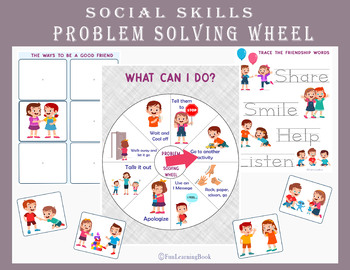
Problem solving wheel , social skills, friendship

Problem Solving Wheel (Social Skills Groups)

Ferris Wheel : Order of Operations Without Negatives (Distance Learning)

Problem Solving Solution Wheel
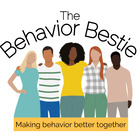
Wheel of Choices SEL Problem Solving

Problem Solving Wheel FREEBIE

Problem Solving Wheel

Problem solving wheel with pictures


Problem Solving Wheel -- Multiple Solutions

Social Skills Problem Solving Wheel Mini for Keyring
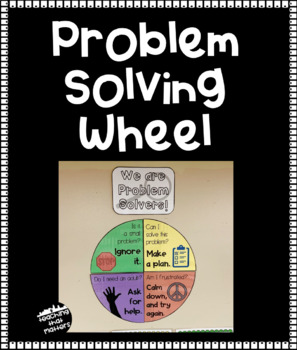
Word Wheel Challenge - Problem Solving Activity

Social Problem - Solving Fix It Wheel

"Calming Choices Wheel " for Self-Regulation

The Color Monster - Feelings spinning wheel ppt PowerPoint

Life Balance Wheel For Teens

FREE! Wagon Wheel Words: Spelling, Reading, Artic. & Problem Solving Skills

Conflict Wheel

fun math additional, subtraction wheel for first grade

Triple Cypher Code Wheel

Maths Concept Wheels

Wheel of Choices

Doorways to Learning with Cipher Wheels

- We're hiring
- Help & FAQ
- Privacy policy
- Student privacy
- Terms of service
- Tell us what you think

Tuesday, September 22, 2020
The abcs of problem solving steps {free printable included}.

Knowing how to solve a problem is just one of many social skills kids, teens, and adults need to learn.
There are a few steps involved in problem solving so it's always good to have a visual cue that breaks down the different steps, especially for autistic and hyperlexic individuals who find visual supports particularly helpful.
And, since the alphabet is kind of our thing around here, I want to share the ABCs of problem solving with you. Well, actually it's more like the ABCDE of problem solving, but whatever, close enough.
Regardless, this is an example of how you can take your hyperlexic child's interest (letters) and use it to teach new skills (problem solving). Something I discuss here .

5 Steps to Solving a Problem
Here's how to use the ABCs of problem solving:
Step 1: Ask
This step is all about asking yourself the following questions:
- Is there a problem?
- What is the problem?
- How big is the problem?
Step 2: Brainstorm
Step 3: choose, step 4: do it, step 5: evaluate.

Download the Free Printable Problem Solving Chart
This one page printable outlines the five problem solving steps from above. It includes a colorful letter for each step, a title, and a short description of what to do. I highly recommend laminating for durability.
To get a copy of this free printable, click the link below:
>> Click here to download this free printable
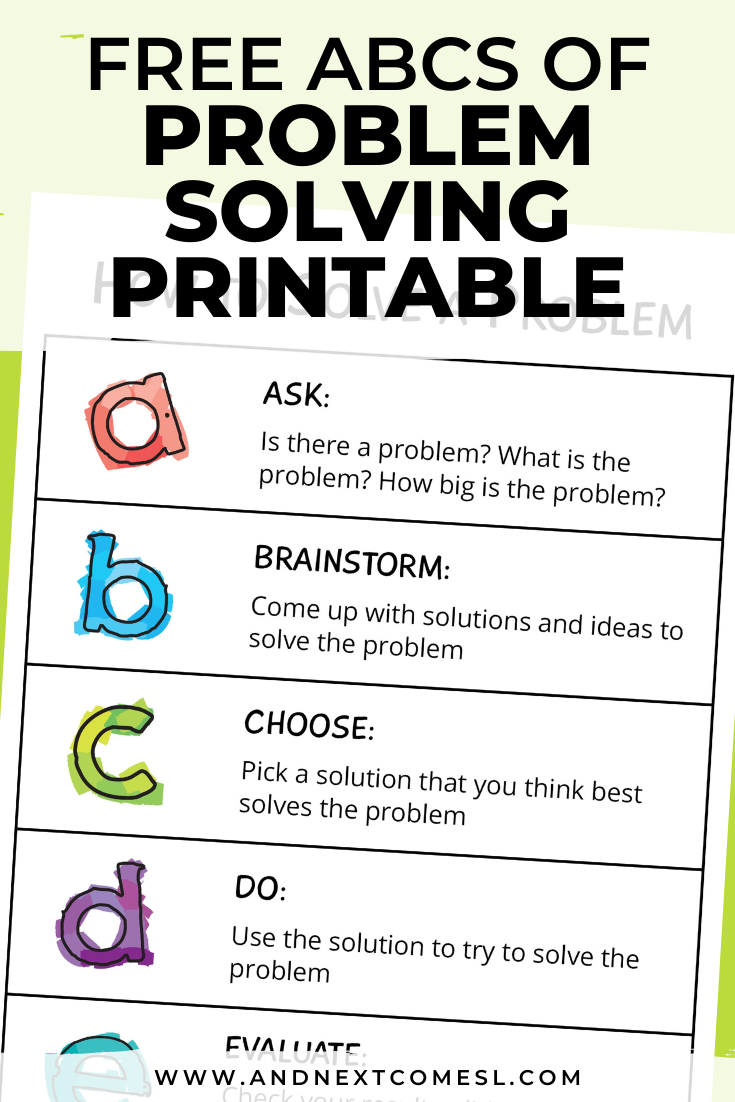
Need one-on-one support? I can help!
Quick links, get connected, where i write.
Classroom Management Toolbox
Eastern Washington University

Problem Solving Wheel
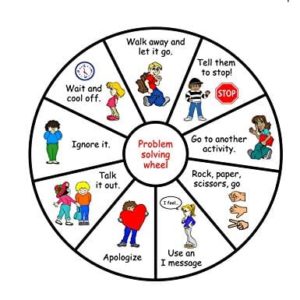
The “Problem Solving Wheel” has many options the student can choose from such as, walk away and let it go, apologize, tell them to stop, ignore it, talk it out, and wait and cool off. Having this tool in the classroom helps minimize the fighting and arguing in the younger grade classes. It helps with giving different options that the students can choose from to handle their difficult situations themselves. For example if a student is constantly taking their classmates scissors or school supplies without asking, their behavior needs to be corrected. They can do this by going to the wheel and choosing the best option to help them make the situation better. In this case it would be to apologize to the other student who they were taking supplies from without permission.

More Information – Tool Source: Pinterest
1 thought on “Problem Solving Wheel”
I am placed in a first-grade classroom with 21 students in a suburban neighborhood. I prepared this tool by finding a wheel of choice that fit my grade level and included age-appropriate choices. I printed three copies of the wheels, laminated them, and stapled them around the room at eye level for students. I introduced the wheel at carpet time with the students, explained each choice on the wheel, and gave examples of what each one would look like in use. Since the wheels have been posted, some students have been referencing the wheel when needed and I have noticed a decrease in escalated conflicts among students. Students understand how the wheel is used and that it is their responsibility to pick a choice that is most appropriate for the situation. An adjustment that could be made to make this tool more effective would be creating a wheel of choice from scratch in collaboration with the students in your class.
Leave a Comment Cancel reply
Save my name, email, and website in this browser for the next time I comment.
Campus Safety
509.359.6498 Office
509.359.6498 Cheney
509.359.6498 Spokane
Records & Registration
509.359.2321
Need Tech Assistance?
509.359.2247
EWU ACCESSIBILITY
509.359.6871
EWU Accessibility
Student Affairs
509.359.7924
University Housing
509.359.2451
Housing & Residential Life
Register to Vote
Register to Vote (RCW 29A.08.310)
509.359.6200

© 2023 INSIDE.EWU.EDU
- International
- Education Jobs
- Schools directory
- Resources Education Jobs Schools directory News Search

Wellbeing - Problem solving Wheel
Subject: Whole school
Age range: 5-7
Resource type: Visual aid/Display
Last updated
7 August 2023
- Share through email
- Share through twitter
- Share through linkedin
- Share through facebook
- Share through pinterest

Have you noticed that your children can tell you when they’re transitioning from green to yellow zones on the playground or in the classroom, but most of the time they can’t pick the right solution to help them get back to green? Well, I found myself being told to say ‘Stop, think and choose’ but what if they don’t know what the options are? So I feel giving and showing these options to children on a simple wheel can help them make the right choice.
These editable wheels work really well in my classroom and I’m not saying they are going to work in yours perfectly but they might help. Most behaviour management strategies are trial and error. These wheels may help your children understand how they can solve their problems in class and on the playground.
Creative Commons "Sharealike"
Your rating is required to reflect your happiness.
It's good to leave some feedback.
Something went wrong, please try again later.
This resource hasn't been reviewed yet
To ensure quality for our reviews, only customers who have downloaded this resource can review it
Report this resource to let us know if it violates our terms and conditions. Our customer service team will review your report and will be in touch.
Not quite what you were looking for? Search by keyword to find the right resource:
- My Storyboards
Problem Solving Worksheets
Customize problem solving worksheets.

What is Problem Solving?
It is the cognitive process of identifying, analyzing, and finding solutions to challenges or issues. It involves using logical and creative thinking to address obstacles that occur, make decisions, and achieve goals. Consider the five problem-solving steps: identifying the problem, generating possible solutions, evaluating options, selecting the best solution, and implementing it. Understanding the steps is crucial for navigating complex challenges with clarity and efficiency.
What are Problem Solving Worksheets?
These worksheets are structured in such a way that encourages solution-based thinking. Engaging in interactive problem-solving activities can help develop critical thinking skills and creative approaches to overcoming obstacles. While these skills are used in a variety of aspects of life, our worksheets focus on problem solving in mathematics. Printable worksheets provide practice for any child who is learning to master new skills they are taught in class. They are perfect for any level, and can be applied to any type of mathematical problem or unit of study.
Why are They Important and How are They Best Used?
They are great for ensuring that students practice what they have yet to master, since they can be customized by the teacher to meet the class and individual needs. They can be used to practice all kinds of word problems involving addition, subtraction, multiplication, division, and so much more.
In a world where challenges are inevitable, the ability to tackle problems effectively is a valuable skill that can be applied across all subjects and age groups. Problem-solving skills are the generator of success. They empower individuals to navigate complex situations, identify triggers, and develop plans to overcome obstacles. From the classroom to the boardroom, these skills are in high demand.
Tailoring Problem-Solving Worksheets for Different Subjects
Mathematics.
Math problem-solving worksheets can be a playground for nurturing critical thinking. Through word problem worksheets, students not only practice calculations but also apply math concepts to real-world scenarios.
Scientific problem-solving worksheets ignite curiosity. They prompt students to hypothesize, design experiments, collect data, and draw conclusions, fostering a scientific mindset.
Language Arts
Language skills and critical thinking intertwine in language arts problem-solving worksheets. Analyzing literature, engaging in creative writing prompts, and correcting grammar offer a holistic approach.
Social Studies
History comes to life through problem-solving worksheets. Encourage students to ponder over historical dilemmas and global challenges, nurturing their ability to think beyond the surface.
Math Worksheet Activity Ideas
- "Math Detective" Challenge: Create a set of worksheets featuring a fictional mystery storyline. Each worksheet presents a clue that requires students to solve a math problem to unveil the next piece of the puzzle. This engaging activity encourages critical and sequential thinking.
- "Math Menu" Project: Design a menu-style worksheet with various math problems categorized by difficulty levels. Allow students to choose a certain number of problems from each category to complete, giving them autonomy and catering to their individual skill levels.
- "Design Your Dream House" Activity: Provide a worksheet that guides students through designing their dream house layout. They need to calculate room dimensions, total area, and even budget constraints. This hands-on activity integrates math into real-life scenarios.
- "Math Art Gallery" Exhibition: Assign each student a famous artwork and create a worksheet that involves geometric calculations related to the art's dimensions and shapes. Students can then present their findings in a "Math Art Gallery" exhibition.
- "Math in the News" Analysis: Collect recent news articles that involve math-related concepts, such as statistics, percentages, or data analysis. Provide worksheets that require students to analyze the math behind the news and discuss its implications.
- "Budgeting for Vacation" Project: Design a project-based worksheet where students plan a vacation, considering expenses like transportation, accommodations, and activities. They must budget and calculate costs while staying within a specified budget.
- "Math Around the World" Exploration: Create a worksheet that presents math problems related to different countries' cultures, currencies, and measurements. Students solve problems like converting currencies or calculating time zone differences.
- "Mathopoly" Board Game: Design a problem-solving board game where players move through spaces by solving math problems. This interactive approach adds an element of fun while reinforcing math skills.
- "Math Olympiad Simulation" Practice: Prepare a set of challenging math problems similar to those in Math Olympiad competitions. Have students work on these problems individually or in teams to sharpen their skills.
- "Math Interview" Project: Assign each student a famous mathematician or scientist and provide a worksheet that guides them to research and create interview-style questions. This encourages exploration of math history and its relevance.
- "Math Escape Room" Challenge: Develop a series of interconnected math problems that lead students through a virtual "escape room." They must solve each problem correctly to advance to the next step and eventually "escape."
- "Data Analysis Report" Assignment: Provide students with a dataset related to a topic of interest, such as sports statistics or environmental data. They must analyze the data, create graphs, and present their findings in a structured report.
- "Math and Music Fusion" Project: Combine math with music by providing a worksheet that explores concepts like rhythm, frequency, and ratios in music. Students can calculate beats per minute, analyze musical patterns, and even compose their own melodies.
- "Math Recipe Creation" Challenge: Ask students to create a new recipe by adjusting ingredient quantities based on serving sizes. They must calculate ratios, proportions, and conversions to ensure the recipe's success.
Designing Effective Problem-Solving Worksheets
Creating successful problem-solving worksheets involves careful planning. Here are some ideas to consider:
- Define the Learning Objective: Clarify the specific mathematical concept you want to reinforce with the worksheet. Outline the steps involved and determine how this worksheet will contribute to improving their skills.
- Select a Problem Type: Choose a math problem type that aligns with the learning objective. It could involve algebraic equations, geometry calculations, or even practical scenarios related to everyday life.
- Structure the Steps: Break down the problem-solving process into logical steps. Ensure that each step reflects the problem solving steps you want students to follow, such as understanding the problem, planning, solving, and verifying.
- Incorporate Interactive Elements: Integrate interactive elements like multiple-choice questions, fill-in-the-blanks, or even drawing areas to encourage problem solving exercises within the worksheet.
- Utilize Graphic Organizers: Introduce a visual problem solving graphic organizer to help students map out their thinking. This can include spaces for writing down given information, variables, and equations.
- Provide a Problem Solving Template: Offer a structured template that guides students through the problem-solving process. Include prompts and placeholders for each step to provide clear direction.
- Encourage Exploration: Inspire students to explore different types of techniques to arrive at solutions. Encourage them to think critically and try various strategies before settling on an approach.
By incorporating these elements, you can create a comprehensive problem solving worksheet for kids that not only teaches mathematical concepts but also equips them with transferable skills. Whether you're focusing on basic arithmetic or more advanced mathematical principles, this approach ensures an engaging and educational experience for young learners.
More Storyboardthat Resources and Free Printables
- Multiplication Worksheets
- Subtraction Worksheets
- Game Worksheets
- Task Card Maker
How to Make a Problem Solving Worksheet
Choose one of the premade templates.
We have lots of templates to choose from. Take a look at our example for inspiration!
Click on “Copy Template”
Once you do this, you will be directed to the storyboard creator.
Give Your Worksheet a Name!
Be sure to call it something related to the topic so that you can easily find it in the future.
Edit Your Worksheet
This is where you will include directions, specific images, and make any aesthetic changes that you would like. The options are endless!
Click "Save and Exit"
When you are finished, click this button in the lower right hand corner to exit your storyboard.
From here you can print, download as a PDF, attach it to an assignment and use it digitally, and more!
Happy Creating!
Frequently Asked Questions About Problem Solving Worksheets
How can math problem-solving worksheets show students how to improve problem-solving skills.
They provide structured exercises that guide students through real-world scenarios. By actively engaging in these worksheets and activities, children can practice the problem solving process, enhancing their critical thinking and logical reasoning abilities.
What strategies can I use to teach problem-solving skills using math worksheets?
Incorporate helpful math problem solving worksheets for kids into your lessons. Support and encourage students to work through the problem-solving steps: understanding the problem, devising strategies, making calculations, and verifying their solutions. Provide examples, guidance, and feedback to nurture their problem-solving skills.
How can I ensure that students grasp the problem-solving process effectively?
Provide clear instructions in your math problem-solving worksheets that guide students through each step of the process. Offer examples and encourage them to discuss their approaches. By nurturing a supportive and collaborative environment, you can help both younger kids and older kids build confidence in their problem solving skills.
What are specific examples of how to teach problem-solving skills in math using pre-answered solution worksheets?
Teaching problem-solving skills in math using pre-answered solution worksheets can be exemplified through scenarios like quadratic equations. Present the class with a quadratic equation and a pre-answered solution that breaks down the steps of factoring or using the quadratic formula. This guides them to understand the process, identify key components, and apply appropriate methods. Similarly, for geometry, offer a challenging problem involving angles or area calculations, along with a pre-answered solution that demonstrates the application of relevant geometric principles. As students work through the problem and compare their reasoning with the pre-answered solution, they grasp problem-solving strategies, logical sequences, and the importance of meticulous calculations. In both cases, these worksheets instill confidence, reinforce systematic approaches, and enhance students' problem-solving skills while navigating mathematical complexities.
Pricing for Schools & Districts
Limited Time
- 10 Teachers for One Year
- 2 Hours of Virtual PD
30 Day Money Back Guarantee • New Customers Only • Full Price After Introductory Offer • Access is for 1 Calendar Year

- Thousands of images
- Custom layouts, scenes, characters
- And so much more!!
Create a Storyboard
Limited Time. New Customers Only
Back to school special!
Purchase orders must be received by 9/6/24.
30 Day Money Back Guarantee. New Customers Only. Full Price After Introductory Offer. Access is for 1 Calendar Year
Generating a Quote
This is usually pretty quick :)
Quote Sent!
Email Sent to
Problem wheel
Examples from our community, 10,000+ results for 'problem wheel'.
If you’re a parent whose school uses Kelso’s Choice, you can learn about the program on these pages.
First, congratulations! We love hearing about school districts and counselors who choose to invest in a peaceful school environment by implementing Kelso’s Choice. Kelso has been beloved since it was first developed by a school counselor and a school psychologist decades ago as a simple and effective way to teach kids how to solve small conflicts.
The program’s success begins with its simplicity. Kids as young as preschool (and even those who aren’t strong readers yet) can benefit from learning Kelso’s Choices. The program puts power in kids’ hands to be problem solvers and gives everyone at school a shared language to help kids get along.
How? It’s simple! First, using the tools the program provides, counselors and teachers show kids the difference between a big problem and a little problem. Once kids know that difference, Kelso’s Choice offers them a variety of tools to solve small problems.
And learning those tools is fun! There are plush puppets, a storybook, bright posters and lots of activities kids will do to learn the skills. You can rest easy your child will come to consider Kelso a trusted friend… and will learn valuable skills that will be useful for a lifetime.
Letter to Parents in Spanish – Carta Introductoria a los Padres en español
Kelso’s Choice wheel
Kelso the frog teaches students how to solve “small” problems on their own. “Small” problems include conflicts that cause “small” feelings of annoyance, embarrassment, boredom, etc. “BIG problems” always need to be taken to an adult. These are situations that are scary, dangerous, illegal, etc.

Kelso has nine choices to solve “small problems.” These are illustrated in the Kelso’s Choice Wheel. They include:
- Go to another game
- Talk it out
- Share and take turns
- Tell them to stop
- Make a deal
- Wait and cool off
When a child comes to you to solve their “small problem,” tell them to try one to two of Kelso’s Choices first. If that doesn’t work, then an adult can intervene. Make sure your kids know to ask an adult for help in the event of a “BIG problem.”
K.C.’s wheel
K.C.’s Wheel is for the preteens (grades 4-5) that may be a little too mature for Kelso’s Choice Wheel. There are “minor problems” that cause minor feelings of annoyance, embarrassment, boredom, etc. There are also “SERIOUS problems” that need to be taken to an adult. These are situations that are scary, dangerous, illegal, etc.
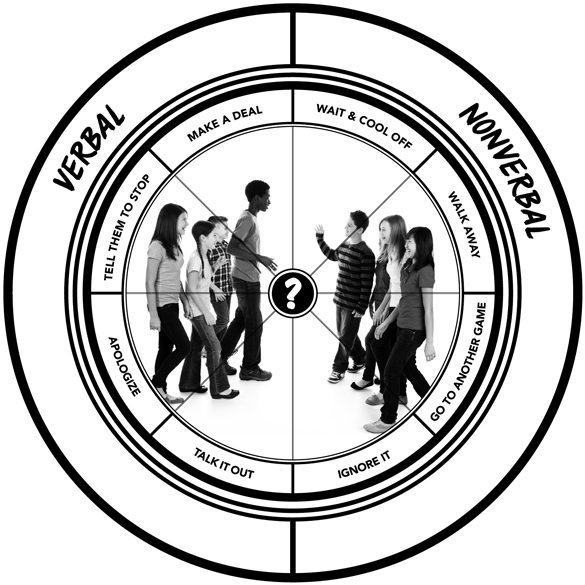
There are eight choices to solve “minor problems.” The choice “share and take turns” has been removed since, typically, at grades 4-5 this skill has been developed. There are “verbal choices” and “nonverbal choices” to solve “minor problems”:
verbal choices:
- Make a Deal
nonverbal choices:
Want to bring more Kelso material into the home? The very best resource for families is the Kelso’s Choice for Families Kit , a kit made…well…just for families!
Want even more? We’ve got board and card games, posters, activity book, story book and more! Visit our Product page or email us at [email protected] .
Like Kelso? Like him on Facebook and benefit by enjoying free activities, discounts and get the latest news!
Did you know?
Parents can decrease sibling rivalry and conflict at home with the Kelso’s Choice for Families Kit!
Click here to learn more about Kelso’s Choice for Families kit:

- Cerebellum Corp. 145 Corte Madera Town Center Suite 406 Corte Madera, CA 94925
- [email protected]
- + 415-541-9901
- 1-805-426-8136
We're not around right now. But you can send us an email and we'll get back to you, asap.
Start typing and press Enter to search
Privacy Overview

IMAGES
COMMENTS
Problem Solving Wheel Freebie. Comes in 4 different versions: Ready-Made: "What can I do?" choice wheel is ready to use right away. Simply download, print and start using this freebie! Blank with Pictures: Have your students add their own words to the pictures. Blank: Have your students draw their own pictures and write a short description.
Boardmaker Problem-Solving Wheel that you and your teen may enjoy reviewing together. As an option, you can also help your teen identify exactly what kind (s) of problem solving strategies worked best in the past and create a custom ^Problem Solving Wheel. _ Reference Link YouTube How to Teach Kids Better Problem Solving
Using a solution wheel is a great resource to help them figure out different ways to solve a problem. One of the reasons I do like this lesson is because it's working on solving problems AND you can also make it a crafts project. Yay!! What you'll need: Solution Wheel (in the printable) Arrow (in the printable) Construction Paper. Metal Brad ...
Walk away and Wait and cool off. Ignore it. Talk it out. let it go. Problem solving wheel Tell them to stop! STOP 60 to another activity. Rock, paper, scissors, go Use an I message Apologize.
We have included three of our favorite books on the subject of Problem-Solving Therapy below. 1. Problem-Solving Therapy: A Treatment Manual - Arthur Nezu, Christine Maguth Nezu, and Thomas D'Zurilla. This is an incredibly valuable book for anyone wishing to understand the principles and practice behind PST.
The Wheel of Choice empowers children to solve their own problems instead of putting pressure on the teacher or parent to be the sole problem-solver. In the process, they learn respect for others, cooperation, problem-solving skills, and confidence in their own capabilities. 1. On the last two pages you will find a color Wheel of Choice and a black
Nine, to be exact! The Kelso's Choice Conflict Management Kit is a system for children in grades K-5 to become empowered to solve their own problems. First, the system helps you teach them the difference between a big problem and a little problem. After that, it gives them the tools to resolve conflict on their own.
GENERAL ITEM DESCRIPTION:Empower your students with effective problem-solving skills using this printable solutions wheel. Hang it up in your classroom and help kids learn valuable techniques to tackle common problems and de-escalate challenging situations. With options like "Walk away", "Tell them ...
Browse problem solving wheel resources on Teachers Pay Teachers, a marketplace trusted by millions of teachers for original educational resources.
Problem Solving Wheel A PDF containing an A4 sized problem solving chart with a variety of questions for the children to work through when tackling a - High quality downloadable teaching resource from Teacher's Pet.
Step 1. Identify the Problem Break it down into smaller steps and decide what you need to action first. Step 2. Brainstorm and write down as many ideas as you can that might help solve the problem, no matter how silly they seem - don't dismiss any possible solutions. Step 3. Consider the pros and cons of each possible solution, using a ...
By honing their problem-solving abilities, we're preparing kids to face the unforeseen challenges of the world outside. Enhances Cognitive Growth: Otherwise known as cognitive development. Problem-solving isn't just about finding solutions. It's about thinking critically, analyzing situations, and making decisions.
Problem activity. solving wheel Rock, paper, scissors, go Use an Apologize I message . Title: Problem Solving wheel.jpg Created Date: 10/10/2017 8:13:03 AM ...
Knowing how to solve a problem is just one of many social skills kids, teens, and adults need to learn.. There are a few steps involved in problem solving so it's always good to have a visual cue that breaks down the different steps, especially for autistic and hyperlexic individuals who find visual supports particularly helpful.
Problem Solving Wheel. This classroom management tool helps with getting younger students to make good decisions by themselves. If their behavior needs to be corrected they have options on the wheel and can decide for which one is the better option that goes with their particular situation. The "Problem Solving Wheel" has many options the ...
Wellbeing - Problem solving Wheel. Subject: Whole school. Age range: 5-7. Resource type: Visual aid/Display. File previews. pptx, 1.28 MB. Have you noticed that your children can tell you when they're transitioning from green to yellow zones on the playground or in the classroom, but most of the time they can't pick the right solution to ...
worksheet. Guide your clients and groups through the problem solving process with the help of the Problem Solving Packet. Each page covers one of five problem solving steps with a rationale, tips, and questions. The steps include defining the problem, generating solutions, choosing one solution, implementing the solution, and reviewing the process.
Welcome to the home of Kelso's Choice, the leading tool for teaching conflict management skills for children Pre-K through 5th grade. Home of the beloved choice wheel, this conflict resolution curriculum teaches children the difference between big problems and little problems. Kelso the Frog is a fun and engaging way for children to learn ...
Consider your own behavior, as well as external factors. Define your problem. Be as clear and comprehensive as possible. If there are many parts to your problem, describe each of them. TIP: If you find it difficult to separate your emotions from the problem, try to complete this step from the perspective of an impartial friend.
10,000+ results for 'problem solving wheel'. Problem Solving Situations Spin the wheel. by Blanigan. Speech Language Problem situations. Problem Solving Spin the wheel. by Katelyna. PROBLEM SOLVING Flip tiles. by Spizarro1. Problem Solving Speaking cards.
Tailoring Problem-Solving Worksheets for Different Subjects Mathematics. Math problem-solving worksheets can be a playground for nurturing critical thinking. Through word problem worksheets, students not only practice calculations but also apply math concepts to real-world scenarios. Science. Scientific problem-solving worksheets ignite curiosity.
Organizational Problem Wheel - Problem Solving Situations - emoji spinning wheel - Movement cool down wheel. - Random but fun questions - Problem Solving. Community Problem wheel. Examples from our community 10,000+ results for 'problem wheel' Organizational Problem Wheel Spin the wheel. ... Get a pack of printable and interactive activities;
K.C.'s wheel. K.C.'s Wheel is for the preteens (grades 4-5) that may be a little too mature for Kelso's Choice Wheel. There are "minor problems" that cause minor feelings of annoyance, embarrassment, boredom, etc. There are also "SERIOUS problems" that need to be taken to an adult. These are situations that are scary, dangerous ...